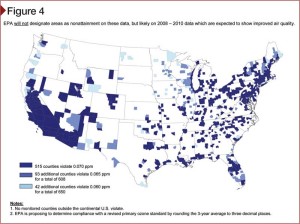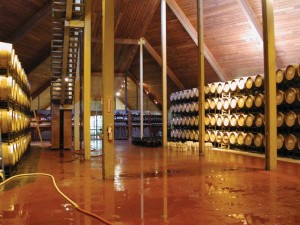
Jurisdictions across the United States are adopting sustainable building programs that incorporate USGBC’s Leadership in Energy and Environmental Design (LEED) rating system, which is widely regarded as the national standard in green building. Using low-VOC coatings that ensure good indoor air quality (IAQ) is one way buildings can earn points toward LEED certification.
For example, Boston’s municipal zoning code requires that all large-scale projects meet LEED certification standards.(Other cities requiring LEED certification range from Arlington, Massachusetts, and Atlanta, Georgia, to New York City and Scottsdale, Arizona. In California, all new state buildings and renovation projects are required to attain certification. [Similar requirements exist in many of the state’s cities.] On a national level, U.S. General Services Administration [GSA] had adopted the LEED green building program to achieve the sustainability objective for public buildings, but is currently considering other green building certification programs.) This mandate has resulted in a new generation of sustainable developments, including the new 31-story Atlantic Wharf mixed-use project located on the Fort Point waterfront. Designed to use 33 percent less energy and 69 percent less domestic water than comparable downtown office towers, Atlantic Wharf features interior and exterior coatings that assisted the developer in achieving LEED Platinum certification. The coatings included a high-solids fluoropolymer finish, which was selected to achieve the performance requirements of gloss and color retention and resistance to UV and abrasion.
A similar high-solids fluoropolymer coating system was used for a LEED Gold project—the award-winning structural steel ‘tiara’ above the 41-story Great American Tower in Cincinnati, Ohio. Weighing more than 400 tons, the iconic tiara design was a winner of the prestigious 2012 Innovative Design in Engineering and Architecture with Structural Steel awards program presented by the American Institute of Steel Construction (AISC).
The new generation of low-VOC coating technology is also being specified for an increasing number of industrial applications, including bridges, potable water tanks, and even public artwork.
Future developments
ACA recently reported SCAQMD is considering a 25-g/L VOC limit for selected coatings. Earlier this year, the California Supreme Court upheld SCAQMD’s authority to enact stiffer air-quality rules on AIM coatings “based on technologies that do not currently exist but are reasonably anticipated to exist by the compliance deadline.”
EPA has also proposed lowering the ozone standard. Adoption of a new standard could leave large areas of the country in non-attainment for ozone air pollution and likely require more local or statewide VOC regulations (Figure 4). EPA is expected to propose its new revisions next fall and finalize the standard in 2014.
This spring, USGBC is scheduled to hold its ballot on LEED v4, which focuses on increasing technical stringency from past versions and developing new requirements for project types such as data centers, warehouse distribution centers, hotels and motels, existing schools, and retail buildings. As VOC limits are ratcheted down, specifiers and engineers will be challenged with finding products that comply with these credit requirements, while still providing the performance needed for the intended use of the coating.

For technical information on low-VOC coatings such as volume solids, common use, VOC levels, curing times, and theoretical coverage, specifiers can refer to the manufacturer’s product data sheets and marketing literature. The manufacturer’s representatives for these products need to be consulted during the specification process and kept informed of project details and performance requirements to make VOC-compliant coating recommendations.
Specifiers are advised low-VOC coatings that are waterborne or contain high solids are often less forgiving of surface contamination and moisture than traditional solvent-based coatings. Knowledgeable coating consultants and technical service representatives can be invaluable sources of information on low-VOC technologies, which often require closer attention during surface preparation, mixing, and application. Manufacturer representatives can offer helpful advice on the use of thinners and other field-applied components, which can elevate the coating’s VOC content and make it noncompliant with local regulatory standards.
Given all the variables and nuances that can affect the selection and use of low-VOC technologies, specifiers should always require coating representatives or manufacturers to document, in writing, their compliant recommendations for coatings based on their intended use.
Terry Wallace, CSI, CDT, LEED AP, is vice president of sales for Tnemec Company. He has an extensive background in architectural coatings and troubleshooting moisture-intrusion issues involving all types of masonry structures. Wallace is an active member of Construction Specifications Institute (CSI), and a Level III certified coating inspector under NACE International–The Corrosion Society. He has chaired the Society for Protective Coatings’ Fluoropolymer Committee, and is a certified consultant of concrete masonry under the National Concrete Masonry Association (NCMA). Wallace holds a bachelor’s degree in industrial marketing management from California State Polytechnic University. He can be contacted at wallace@tnemec.com.




